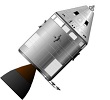 Today, when developing embedded control systems, it is standard practice to test control algorithms against some kind of “world model”, “plant model” or “environment simulator”.
Today, when developing embedded control systems, it is standard practice to test control algorithms against some kind of “world model”, “plant model” or “environment simulator”.
Using a simulated control system or a virtual platform running the actual control system code, connected to the world model lets you test the control system in a completely virtual and simulated environment (see for example my Trinity of Simulation blog post from a few years ago). This practice of simulating the environment for a control computer is long-standing in the aerospace field in particular, and I have found that it goes back at least to the Apollo program.
Continue reading “Simulation and the Apollo Guidance Computer”